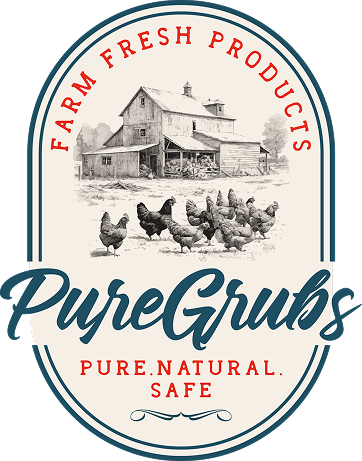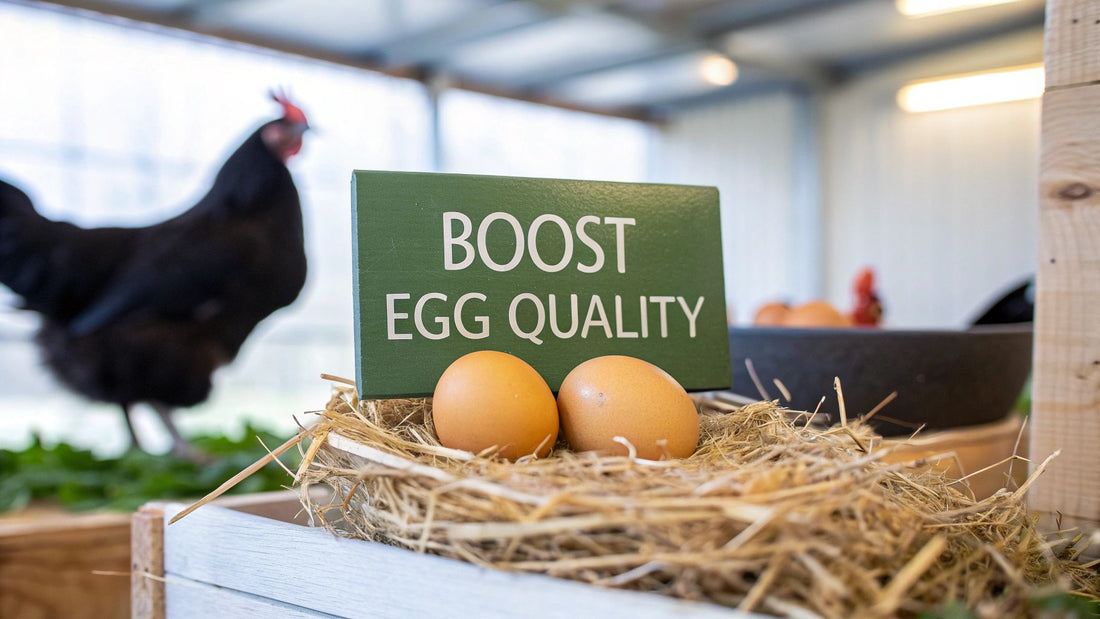
How to Improve Egg Quality for a Healthier Flock
Share
If you’re looking to boost the quality of your eggs, the secret lies in focusing on your flock’s nutrition, environment, and overall happiness. A well-fed hen in a clean, safe coop with minimal stress is a hen that will lay strong, healthy eggs. It’s that simple.
Understanding What Makes a Quality Egg
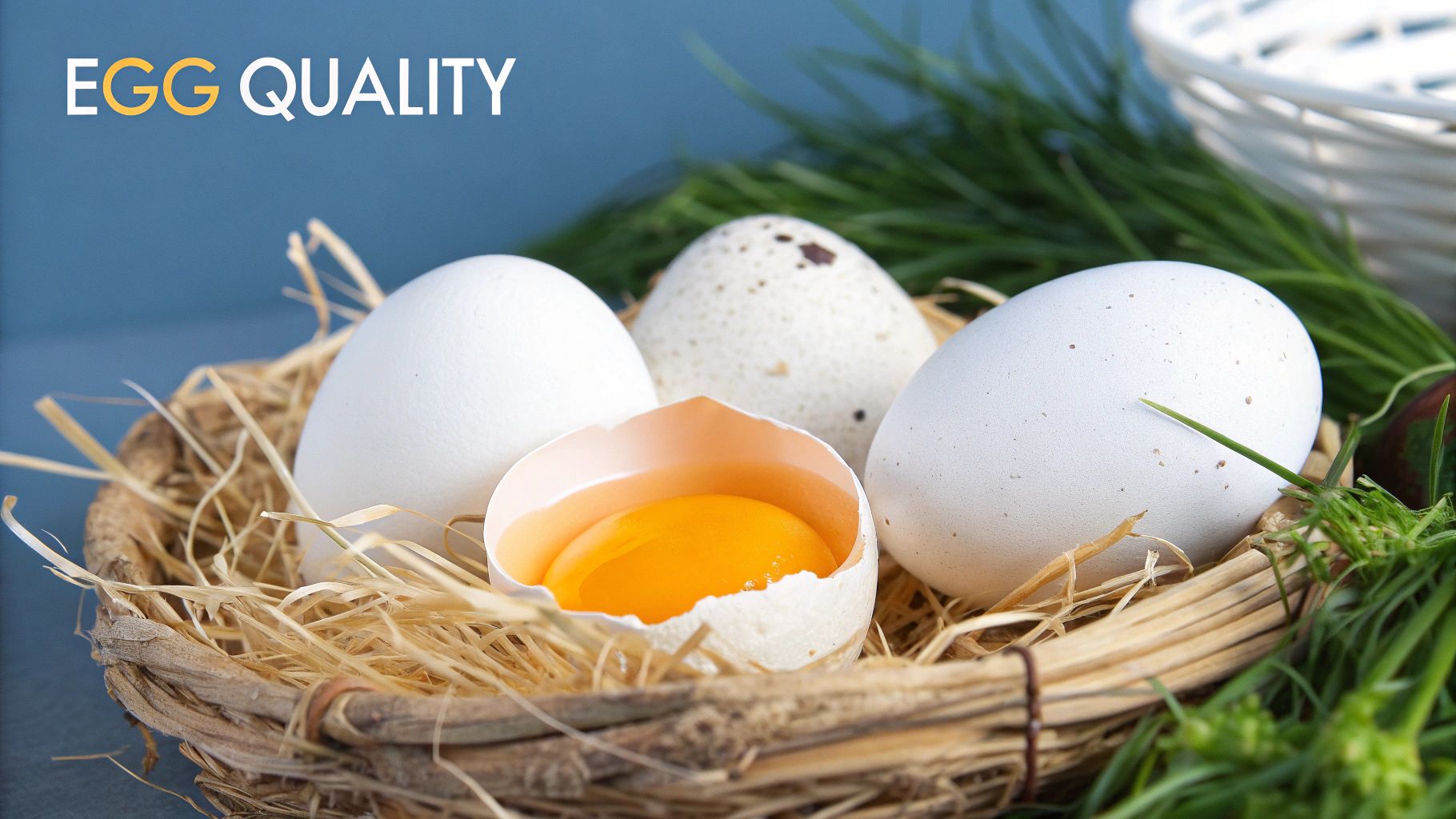
Before we start tweaking things, let's get on the same page about what a "good" egg really is. Think of an egg as a daily report card on your hen's health. What you see when you crack it open tells you a story about how well she’s doing.
A truly high-quality egg has a few tell-tale signs. The yolk should be a vibrant, deep golden-orange, and it should stand up proudly, not flatten out immediately. The egg white (the albumen) is another key indicator. You want to see two distinct parts: a thick, almost jelly-like layer that surrounds the yolk, and a thinner, more watery layer around that. A firm, well-defined white means the egg is fresh and packed with good protein.
The Anatomy of a Perfect Eggshell
The shell is an egg’s suit of armor and the first thing you notice. A great shell is smooth, evenly shaped, and feels solid in your hand, with no obvious weak spots or cracks. This protective barrier is made of about 95% calcium carbonate, which is why a hen’s calcium intake is non-negotiable for strong eggs.
On the flip side, some clear red flags point to poor quality:
- Thin or Brittle Shells: If the shell cracks at the slightest touch, it’s a dead giveaway of a calcium deficiency or an issue with how she’s absorbing it.
- Watery Whites: An albumen that spreads out like water in the pan, with no clear definition, usually means the egg is old or the hen's diet is lacking.
- Pale Yolks: A washed-out, light yellow yolk often indicates a diet missing key pigments called xanthophylls, which are found in leafy greens, yellow corn, and high-quality supplements. Adding treats like dried grubs for chickens can introduce beneficial fats and proteins that help deepen that yolk color.
Sometimes, a quick visual check is all you need. Here's a handy reference to help you spot the difference between a great egg and one that signals a problem.
Quick Guide to Identifying Egg Quality
| Indicator | Sign of High Quality | Sign of Low Quality |
|---|---|---|
| Shell | Smooth, thick, and uniform. Free of cracks. | Thin, brittle, misshapen, or has soft spots. |
| Yolk | Deep golden-orange color. Stands tall and round. | Pale, light yellow. Flattens out immediately. |
| Albumen (White) | Two distinct parts: a thick inner layer and a thin outer layer. | Spreads out thinly like water. No clear definition. |
| Air Cell | Small and less than 1/8 inch deep. | Large and deep, indicating an older egg. |
Seeing these signs helps you connect the dots back to your flock's diet and living conditions.
Key Factors That Influence Egg Quality
While nutrition is the star player, a few other factors have a big say in the kind of eggs your flock produces.
Age of the Hen
A hen’s age has a huge impact. Young hens (pullets) who are just starting out often lay smaller eggs and might throw in some oddballs, like double-yolkers, as their systems get up and running. Once a hen hits her prime laying years, usually between 1-2 years old, her eggs are typically at their peak in terms of shell strength and consistency. As hens get older, they tend to lay larger eggs, but the shells get progressively thinner, making them much more fragile.
Breed and Genetics
The breed of chicken you have absolutely matters. Some, like Leghorns and Rhode Island Reds, are egg-laying machines bred for consistent quality. On the other hand, heritage or ornamental breeds might lay fewer eggs or have unique shell colors, like the beautiful blue eggs from Ameraucanas or the deep, chocolate-brown eggs from Marans.
Pro Tip: Know your breed! Understanding what’s normal for your specific chickens helps you set realistic expectations. You can’t expect a Silkie to lay like a commercial hybrid, but you can definitely take steps to make sure the eggs she does give you are the best they can be.
Building Strong Eggs from the Inside Out
Great eggs don’t just happen by accident; they start with great nutrition. It really is the foundation for everything your hen produces. While a standard layer feed is a decent starting point, if you want truly outstanding eggs, you need to look a little deeper.
Think of it this way: every single part of an egg, from the shell right down to the yolk, is built directly from what your hen eats. That's why a one-size-fits-all approach often falls short. Knowing what to look for on a feed label—and how to supplement smartly—can completely transform your egg basket.
The Unbeatable Importance of Calcium
A strong, solid eggshell is about 95% calcium carbonate. This makes calcium the undisputed king of egg quality. To form a proper shell, a laying hen needs a surprising amount of it—roughly four grams every single day. If she doesn't get it from her diet, her body will start pulling it from her own bones. This leads to weak, rubbery shells and, over time, a weak, unhealthy hen.
This is why just tossing out a complete layer feed isn't always enough. High-producing breeds and older hens, whose bodies aren't as efficient at absorbing calcium, often need more. The best solution is offering free-choice supplemental calcium. This lets each hen take exactly what her body tells her she needs.
Two of the best sources are:
- Crushed Oyster Shell: This is the classic choice for a reason. It provides a slow-release source of calcium that hens can access whenever they need it, day or night.
- Crushed Eggshells: A fantastic way to recycle! Just be sure to clean, dry, and crush them thoroughly so the hens don't recognize them and develop an egg-eating habit.
Always offer supplemental calcium in a separate dish, not mixed into the main feed. Mixing it in forces every hen to get the same amount, which can cause health issues for those who get too much or not enough. Let them self-regulate.
Protein Power for Perfect Egg Whites
The egg white, or albumen, is basically just protein and water. How firm it is comes down directly to the protein quality in your hen’s diet. A hen laying an egg every day is putting a huge amount of protein into that shell, and it all has to be replenished.
If you're cracking open eggs with thin, watery whites that spread all over the pan, it’s a big red flag that your feed might be lacking in protein. A good layer feed should contain 16-18% protein. Take a second to check the tag on your feed bag and see where it stands.
For a little extra boost, especially during a molt when they need tons of protein to regrow feathers, you can offer healthy, protein-rich snacks. Scrambled eggs, fish meal, or high-quality insect treats are all excellent choices that your flock will go crazy for. If you want to dig deeper into the dietary details, this comprehensive guide on what to feed laying hens is a great resource for crafting the perfect meal plan.
Vitamins and Fats for Vibrant Yolks
We all love seeing that rich, deep orange yolk. It’s more than just pretty—it’s a sign of a well-rounded diet packed with specific nutrients. A pale, sad-looking yolk often means a diet is missing key vitamins and pigments that go beyond just protein and calcium.
The two most important players here are:
- Vitamins A and D: Vitamin A is vital for reproductive health, but Vitamin D is the real hero for eggshells. It's essential for calcium absorption. A hen can have all the calcium in the world, but without enough Vitamin D, she can't use it effectively.
- Xanthophylls: These are the natural yellow-orange pigments found in plants. They are what give yolks that beautiful color. Hens can't make these themselves; they have to come from their food.
You can find these nutrients in abundance in natural sources like:
- Leafy greens like kale, spinach, and even dandelion greens
- Yellow corn and marigold petals
- Fresh pasture where they can forage
Letting your flock roam and forage for greens and bugs is one of the best things you can do. It doesn't just improve their egg quality; it contributes to their overall health and happiness, making for a much more interesting life than just eating from a feeder. The result is a healthier bird and a more beautiful, nutritious egg for your breakfast.
Using Supplements to Enhance Egg Quality
Even when you’ve dialed in the perfect feed and your hens have plenty of room to roam, sometimes their diet needs a little extra something. Think of targeted supplements as nutritional insurance—they fill in the gaps and can take your egg quality from good to truly fantastic.
This isn’t about replacing a solid diet, but rather fine-tuning it. With the right additions, you can tackle specific issues like weak shells during a heatwave or boost the nutritional value of your yolks. You'll often see a visible difference in just a few weeks.
The Powerhouse: Black Soldier Fly Larvae
When you’re looking for a supplement that packs a serious punch, Black Soldier Fly Larvae (BSFL) are in a league of their own. They blow common mealworms out of the water with a nutritional profile that seems custom-made for laying hens. Their biggest claim to fame? An incredibly high calcium content.
BSFL naturally accumulate calcium in their bodies, making them a highly bioavailable source that hens can absorb and use right away. This translates directly into stronger, thicker eggshells that resist cracking. A laying hen needs about four grams of calcium every single day to form a proper shell, and a handful of BSFL gives her a serious head start.
But it’s not just about calcium. BSFL are also loaded with high-quality protein, often over 40%, which is the key to firm, well-defined egg whites. They also provide a complete amino acid profile to support everything from feather growth to immune function. For a deeper look at how BSFL stack up against other options, check out this guide to the best calcium supplements for chickens.
This chart really puts the nutritional value of supplements into perspective compared to standard feed.
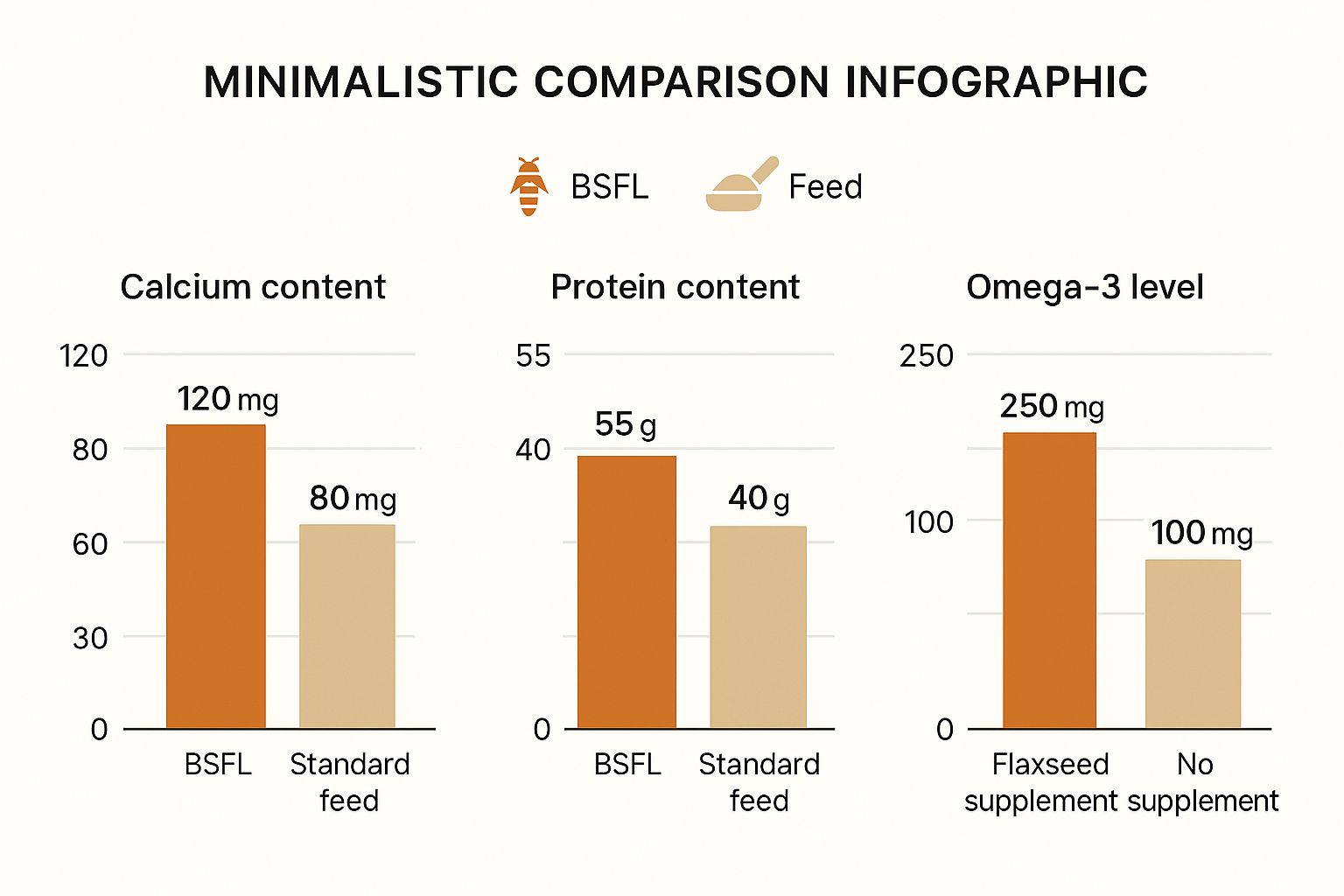
As you can see, adding a high-quality supplement like BSFL dramatically increases the key nutrients your hens are getting.
Probiotics for Better Nutrient Absorption
You can offer your flock the best feed money can buy, but it won't do much good if they can't properly absorb all those nutrients. That's where probiotics come into play. These beneficial bacteria are the workhorses of a healthy gut microbiome, which is the engine of a chicken's entire digestive system.
A healthy gut accomplishes two critical things:
- It supercharges digestion: Probiotics help break down feed more efficiently, unlocking more vitamins, minerals, and protein for the hen to use.
- It builds a strong defense: The gut is the first line of defense against nasty pathogens, so a healthy microbiome leads to a healthier, more resilient flock.
This improved absorption means your hens have more resources to put toward egg production. The result? Better shells, richer yolks, and more consistent laying. Look for poultry-specific probiotics to add to their water or feed.
My Go-To Tip: I like to add a splash of raw, unfiltered apple cider vinegar (the kind with "the mother") to the flock's waterer a couple of times a week. It’s a great natural probiotic that helps maintain a healthy pH in their digestive tract, supporting better nutrient uptake and overall wellness.
Comparing Popular Egg Quality Supplements
With several options available, it helps to see how they stack up. Here’s a quick comparison of some of the most common supplements chicken keepers use to boost egg quality.
| Supplement | Primary Benefit | Best For |
|---|---|---|
| Black Soldier Fly Larvae | High in bioavailable calcium and protein | Strengthening eggshells and improving egg white quality. |
| Oyster Shells | Slow-release calcium source | Providing a consistent, free-choice calcium source. |
| Probiotics | Improves nutrient absorption & gut health | Boosting overall flock health and feed efficiency. |
| Flaxseed (Ground) | Rich in Omega-3 fatty acids (ALA) | Enriching yolk color and nutritional value. |
Each of these serves a purpose, but for an all-around boost, it's hard to beat the combined benefits of a supplement like BSFL.
Boosting Omega-3s for Healthier Yolks
The nutritional profile of an egg yolk is a direct reflection of what a hen eats. One of the best things you can add to that diet is omega-3 fatty acids. We all know these healthy fats are great for us, and by feeding them to your flock, you can enrich your eggs with these powerful nutrients.
The easiest way to do this is by mixing an omega-3 source into their daily feed.
- Flaxseed: A small amount of ground flaxseed is a fantastic plant-based source of ALA (alpha-linolenic acid), an important omega-3.
- Fish Oil: This one is a bit smellier, but it’s a potent source of DHA and EPA. Just be sure to use it sparingly to avoid giving the eggs a fishy taste.
When you enrich your eggs this way, you’re not just improving your flock’s health—you’re producing a better final product for your kitchen. It’s a simple tweak that benefits both your chickens and your family.
Creating a Low-Stress Environment for Your Hens
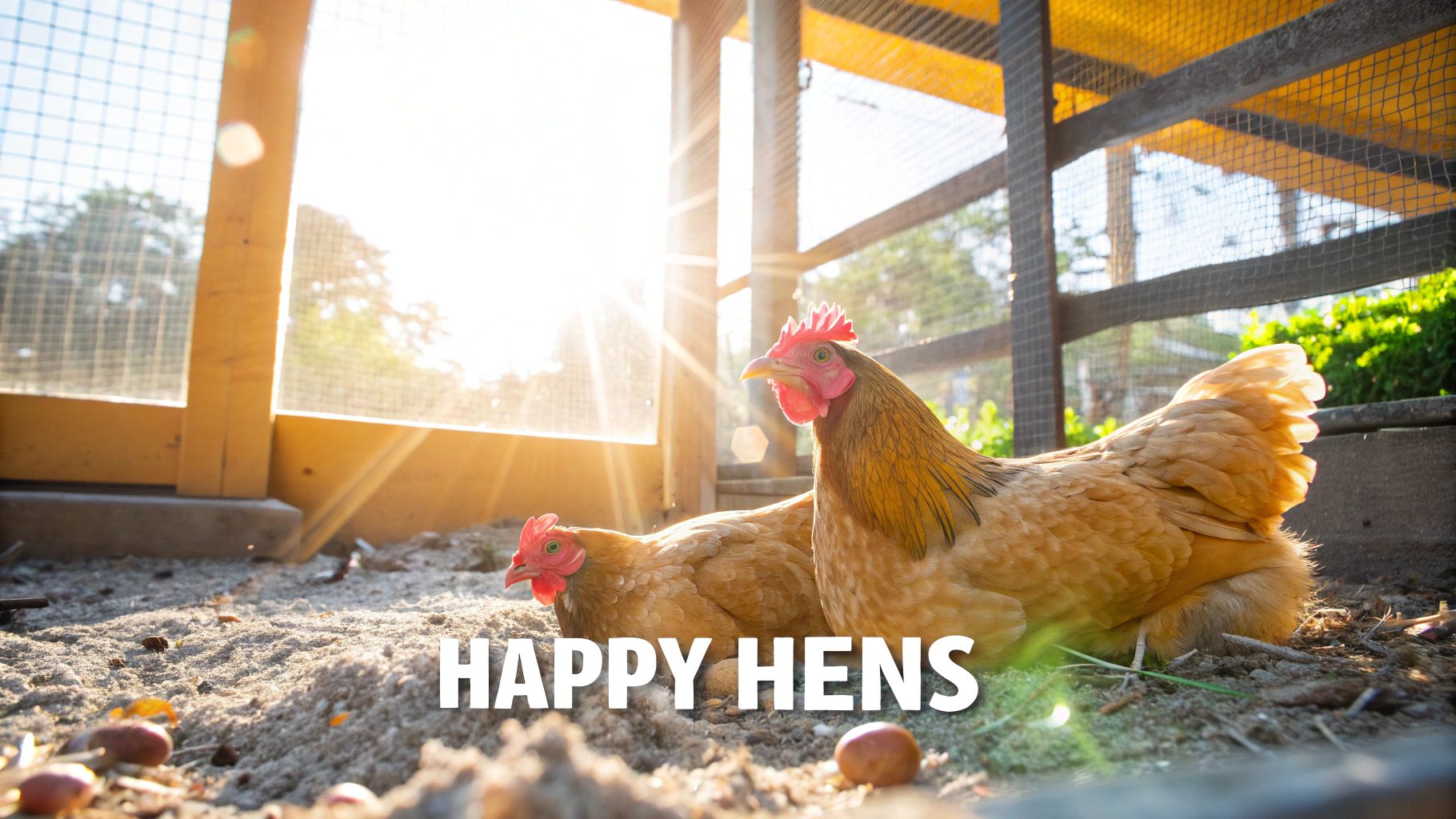
A happy hen lays a better egg. It’s that simple. While the right feed provides the building blocks, a hen's environment dictates her body's ability to put them all together correctly. Stress is the ultimate enemy of consistent, high-quality eggs, causing everything from thin shells to internal flaws.
Think of egg-laying as a delicate assembly line that takes a full 24 to 26 hours to complete. When a hen gets stressed, her body pumps out hormones like cortisol, throwing a wrench in the whole process. This can rush shell formation, leading to weak spots, or even shut down production entirely. A calm, comfortable habitat isn't a luxury; it's a core strategy for how to improve egg quality.
Coop Comforts and Safety
The coop is your flock’s sanctuary—their safe harbor from predators and bad weather. If they don't feel secure, they'll be on edge. Overcrowding is one of the biggest and most avoidable stressors, quickly leading to squabbles, feather picking, and a constant battle for food and water.
Here’s a good rule of thumb for setting up their space:
- Ample Roosting Space: Give each bird at least 8-10 inches of roosting bar. They need to be able to perch comfortably at night without being jammed shoulder-to-shoulder.
- Sufficient Floor Space: Inside the coop, aim for a minimum of 3-4 square feet of floor space for each standard-sized hen. Trust me, more is always better. It gives everyone room to breathe and cuts down on social tension.
- Good Ventilation: Proper airflow is a must for heading off respiratory problems. Vents should be high up, well above the roosts, to let ammonia and moisture out without creating a chilly draft on your birds.
Your flock's behavior is your best report card. If you see hens constantly bickering, hiding, or avoiding the coop altogether, it's a huge red flag that something is off. A peaceful coop is a productive coop.
Nesting Boxes Hens Will Actually Use
The goal here is simple: make the nesting boxes so inviting that your hens want to lay there. Chickens are naturally drawn to dark, quiet, and private spots for laying. If their boxes are bright, filthy, or right out in the open, they’ll find their own "better" spot—like under a thorny bush or in a dusty corner. This just leads to dirty, lost, or broken eggs.
To create the perfect nesting box setup:
- Keep Them Clean and Dry: Line the boxes with a deep layer of soft, clean bedding like pine shavings or straw. A fresh nest is an appealing nest, and it helps keep your eggs looking pristine.
- Ensure Privacy: This is a game-changer. Hang simple curtains made of burlap or an old feed sack over the entrance. That little bit of privacy makes the boxes feel much more secure.
- Provide Enough Boxes: The standard advice is one nesting box for every four to five hens, and it holds true. This prevents a line from forming and stops multiple hens from trying to pile into one box, which is a recipe for cracked eggs.
Making the nesting boxes the most desirable real estate in the coop is a low-effort, high-reward way to protect your eggs and keep your flock calm.
Managing Light and Encouraging Natural Behaviors
Light is the engine of a hen's laying cycle. To keep their reproductive systems humming, hens need about 14 to 16 hours of light per day. This light stimulates a gland that tells their ovaries it's time to release a yolk. It's why, as the days shorten in fall and winter, production naturally tapers off.
If you decide to use supplemental light to keep eggs coming through the winter, be smart about it. A timer that gently fades the light on in the morning is far less stressful than a sudden blast of brightness. And just as important, they need a solid period of total darkness to get proper rest.
Beyond the coop, nothing beats stress like letting chickens be chickens. Activities like foraging, scratching, and dust bathing aren't just hobbies; they're essential for a hen's mental and physical health. A good dust bath is how they stay clean and keep mites and other parasites at bay.
When your flock has the freedom to engage in these natural behaviors, it curbs boredom and prevents bad habits like feather picking. The result is a flock of healthier, happier birds. And as any experienced keeper knows, a happy bird is the secret ingredient for fantastic eggs.
How to Fix Common Egg Quality Issues
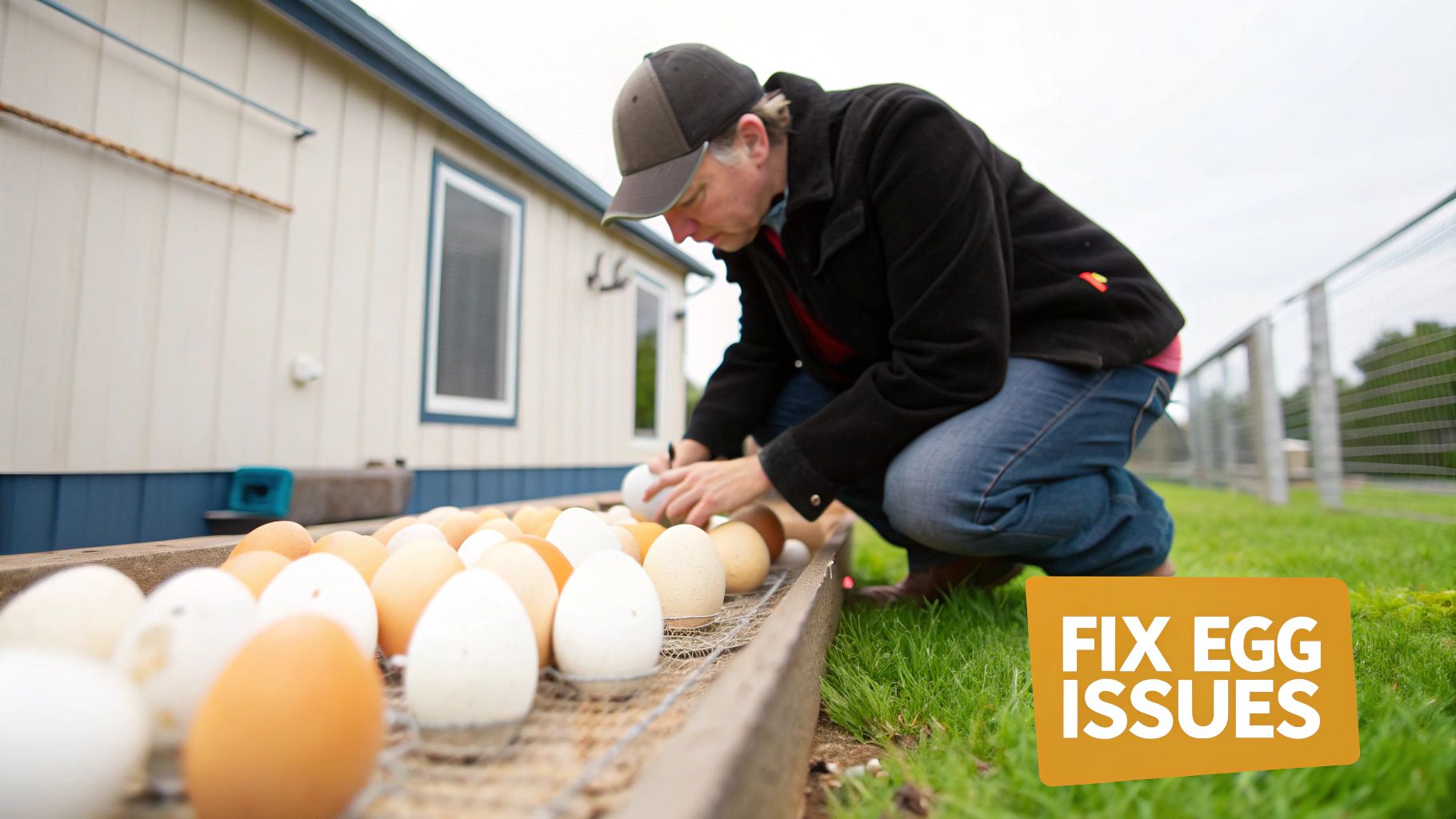
Even with the best care, you're bound to find an oddball egg in the nesting box every now and then. A misshapen, soft-shelled, or just plain weird-looking egg can be a bit startling, but don't panic. More often than not, it’s a sign of a simple, fixable problem.
Most of these issues circle back to a handful of core areas: nutrition, stress, underlying illness, or just the hen's age. By working through the common culprits, you can usually get your flock's egg production back on track in no time.
Dealing with Weak and Paper-Thin Shells
Fragile, thin, or even soft shells are probably the number one complaint I hear from fellow chicken keepers. An eggshell is formed almost entirely overnight, a process that demands a huge amount of calcium from a hen’s body. So, if you're seeing weak shells, calcium is the first place to look.
Ask yourself: are you offering a separate, free-choice source of calcium like crushed oyster shell or your own clean, crushed eggshells? Your layer feed has calcium in it, but for high-production breeds and older hens, it's rarely enough on its own. They need to be able to supplement as their bodies require.
If you’ve got the calcium covered, the next suspect is a lack of Vitamin D. This vitamin is absolutely crucial for calcium absorption. Without enough of it, any extra calcium your hen eats will just pass right through her system. Make sure your flock gets plenty of real sunlight or that your feed is properly fortified with Vitamin D3.
Lastly, don't underestimate stress. Heat stress, in particular, is notorious for causing thin shells because it directly interferes with how a hen’s body deposits calcium onto the egg.
When You Find a Lash Egg
Finding a lash egg is a genuinely jarring experience for any flock owner. It looks less like an egg and more like a rubbery, layered blob of gunk. And that’s essentially what it is—an accumulation of pus and infected tissue shed from a hen’s oviduct.
This is not a dietary problem. A lash egg is a massive red flag for a serious internal infection, most often Salpingitis, which is an inflammation of the reproductive tract.
If you find one, you need to act fast:
- Isolate the hen immediately. This is to prevent any potential spread of infection and to give her a calm space to recover.
- Watch her closely. Look for other signs of sickness, like lethargy, a fluffed-up appearance, or a lack of interest in food and water.
- Get a vet involved. Salpingitis almost always requires antibiotics. Getting a proper diagnosis and treatment plan from a poultry-savvy vet is her best chance for recovery.
A lash egg is your hen screaming for help. It’s a clear signal that something is seriously wrong internally. Taking immediate action is critical for her health.
Understanding Double Yolks and Other Oddities
Pulling a double-yolker out of the nesting box can feel like you've won the breakfast lottery! These are most common with young pullets whose reproductive systems are still working out the kinks. It’s a simple timing error—the ovary releases two yolks too close together, and they both get wrapped up in a single shell.
While usually harmless, if a mature hen starts laying double-yolkers frequently, it might be a sign she’s being pushed too hard by things like excessive artificial light or overly rich feed.
You might also come across other strange, but typically harmless, eggs:
- No Yolk Eggs: Often called "wind eggs" or "fairy eggs," these are tiny eggs that contain only egg white. They're another common quirk in young, newly laying hens.
- Blood Spots: Finding a small red spot on the yolk doesn't mean the egg is fertilized or bad. It’s just from a tiny blood vessel that ruptured when the yolk was released. The egg is perfectly safe to eat.
- Watery Whites: This can be a sign of an aging hen whose eggs are losing a bit of their quality. However, if you see it suddenly appear across your whole flock, it’s worth investigating further for signs of illness, like infectious bronchitis.
A Few Common Questions About Egg Quality
When you're raising chickens, a lot of questions pop up along the way. Let's tackle some of the most common ones that keepers have about getting those perfect eggs.
How Long Until I See Better Eggs After Changing Their Diet?
It's a great question, and the answer has two parts. The entire journey from yolk release to a finished, laid egg takes about 24 to 26 hours. But the yolk itself has been developing for about 10 days before it even starts that final trip.
So, for things that affect the yolk—like adding flax for richer omega-3s or marigold for a deeper orange color—you'll start to see a real difference in about one to two weeks. For shell strength, which depends on building up the hen's calcium reserves, give it a bit longer. You should see consistently stronger shells in two to four weeks.
Does Having a Rooster Around Improve Egg Quality?
This is a classic piece of chicken folklore, but it's just not true. A rooster has zero impact on the nutritional value, shell thickness, or yolk color of an egg. His only role is fertilization.
Fertilized and unfertilized eggs are identical from a nutritional standpoint. So, if your goal is simply better eggs for your kitchen, a rooster isn't part of the solution. Keep your focus right where it matters: on your hens' diet, health, and living conditions.
What's Making My Egg Yolks So Pale?
A pale, washed-out yolk is almost always a dead giveaway that something is missing from your hen's diet. That beautiful, deep orange color we all strive for comes from pigments called xanthophylls, which are found in leafy greens and colorful plants. Hens can't make these on their own; they have to eat them.
If you're seeing pale yolks, it’s a clear sign their feed is lacking. Here's how to fix it:
- Let them forage on fresh pasture. They'll naturally find and eat all sorts of weeds and greens.
- Toss them some dark leafy greens like kale, spinach, or even dandelions from the yard.
- Offer them scraps of yellow and orange veggies like carrots, pumpkin, or sweet potatoes.
- Look for a quality feed or supplement that includes ingredients like marigold petal extract, a fantastic natural color booster.
A diet packed with these natural goodies will turn those lackluster yolks into the vibrant orange beauties you're looking for.
A rich, golden yolk is more than just pretty. It’s a visual confirmation that your hen is enjoying a varied, nutrient-dense diet full of essential vitamins and minerals.
Are Eggs with Blood Spots Safe to Eat?
Yes, absolutely. It can be a little startling to crack open an egg and find a small red spot on the yolk, but it's completely harmless. It’s just from a tiny blood vessel that ruptured on the yolk's surface as it was released from the hen's ovary.
It is not a sign that the egg is fertilized or that an embryo is forming. The egg is perfectly safe to eat. If it bothers you aesthetically, just scoop it out with the tip of a knife. You’ll tend to see these spots more often in young pullets who are just getting the hang of laying, but they don't indicate any health problems.
For a simple, all-in-one treat that provides a natural calcium boost for stronger shells and high-quality protein for richer yolks, think about adding Pure Grubs to your flock's routine. Our USA-grown Black Soldier Fly Larvae are a clean, healthy, and delicious way to support your hens from the inside out. Learn more and give your flock the best at PureGrubs.com.
